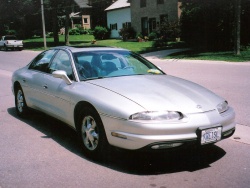 1999 Oldsmobile Aurora. Click image to enlarge |
Article and photo by Bill Vance
Oldsmobile was one of the great names in American automobiles and a member of the General Motors family from 1908 to 2004. As well as being the oldest continuous American nameplate, dating from 1897, it had a long list of pioneering technical achievements.
Olds was the first large-production car (1901 Curved Dash), first with fully automatic transmission (1940 Hydra-Matic), first (along with Cadillac) with a short stroke, overhead valve, high compression V8 (1949 “Rocket” 88), first production car with a turbocharged engine (1962 F-85 Jetfire) and first modern front-wheel drive American car (1966 Toronado).
In addition to its technical triumphs, Oldsmobile’s Rocket 88 model was a power in stock car racing for several years in the 1950s, and its Cutlass/Curlass Supreme was one of the industry’s longest running and most popular models.
But nothing lasts forever, and by the early 1990s Oldsmobile’s glory days were slipping away. From annual production of more than a million cars in the mid-‘80s it slid to less than 400,000 in 1993, even though it had tried to move with the times by introducing its double overhead cam, 16-valve “Quad 4” four cylinder engine, and adding a minivan and an SUV. It was a victim of, among other things, a blurred identity caused by a GM badge engineering policy that produced too many overlapping, lookalike cars. Rumours of Oldsmobile’s demise were soon starting to circulate.
Something was needed to spruce up the image and it came in the form of an exciting new car and an enthusiastic new general manager named John Rock. Rock was a results-oriented, no-nonsense executive and he was determined to inject new life into Oldsmobile.
Rock wanted a complete break with the past, a new type of car that appealed to younger buyers and would go head-to-head with competitors from Japan and Germany with names like Lexus, Infiniti, Mercedes-Benz and BMW. It was to be the beginning of “The New Oldsmobile.”
The car that was to perform this brand-saving feat was the Oldsmobile Aurora, introduced in May 1994 as a ’95 model. Its piece de resistance was mounted transversely under the sharply sloping hood: a slightly shrunk, 250-horsepower, 4.0-litre derivative of Cadillac’s twin overhead cam, 32-valve 4.6-litre aluminum “Northstar” V8 that had arrived in 1992. It drove the front wheels through a four-speed automatic transaxle.
It seemed like ample power, but it had to propel a five passenger sedan that weighed almost 1,814 kg (4,000 lb), despite the use of some aluminum and composites in the body. According to Car and Driver (8/’94) the four-cam V8 sprinted it from zero to 96 km/h (60 mph) in 8.2 seconds and to a top speed of 213 km/h (132 mph). These figures were in line with competitors such as the Lexus ES300 and Mercedes-Benz C220.
Suspension was fully independent with control arms, links and coil springs. Steering was rack-and-pinion and brakes were four-wheel discs with anti-lock.
In addition to being heavy, the Aurora was big, stretching 5,218 mm (205.4 in.) long and mounted on a 2,891 mm (113.8 in) wheelbase. This made it larger than any of its imported competitors and most American cars, and longer than today’s biggest Mercedes-Benz, Audi, BMW and Lexus. Oil crises were now a distant memory, and Rock knew that Americans still loved their big cars.
The Aurora’s styling was fresh and daring with a very stiffly engineered unitized body whose lines flowed from top to bottom with no discernible beltline. Gone were any signs of vinyl roofs or fake wire wheels. Instead was as grille-less front end, bold fender flares, a chopped off tail with a wall-to-wall elliptical frame enclosing the taillamps and reflector. Frameless windows gave a sporty flare, and all in all it was a quite attractive design.
On the inside was none of the excessive ornamentation of the past. Instead was standard leather upholstery, spare use of chrome and real walnut trim. Conveniences included dual-zone climate control, lumbar adjustments and intuitive power seat adjusters a la Mercedes-Benz.
Perhaps significantly, the Oldsmobile name appeared only on the radio, although this would be remedied later when an Oldsmobile badge was put on the rear. With the Aurora name predominating, it was almost as if GM was de-emphasizing the Oldsmobile brand.
Oldsmobile sold close to 48,000 Auroras in its first model year, albeit a long one, a very respectable figure for this class of car. It tailed off significantly in 1996, and continued to slide until it fell to under 20,000 by 1999 when production of the first generation ended.
The name would continue until 2003, but Aurora began to lose its exclusivity as other Oldsmobiles started aping its styling. As good a car as the Aurora was, it didn’t accomplish its brand-saving mission; perhaps it was too much to ask. The Oldsmobile brand was discontinued by General Motors in 2004.







 Follow Autos on Twitter
Follow Autos on Twitter
